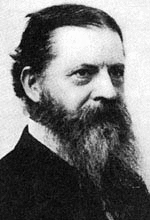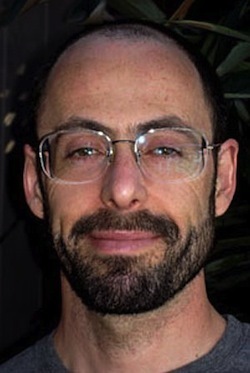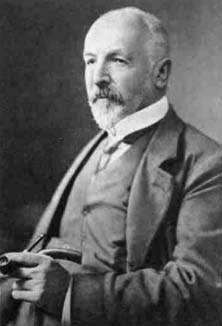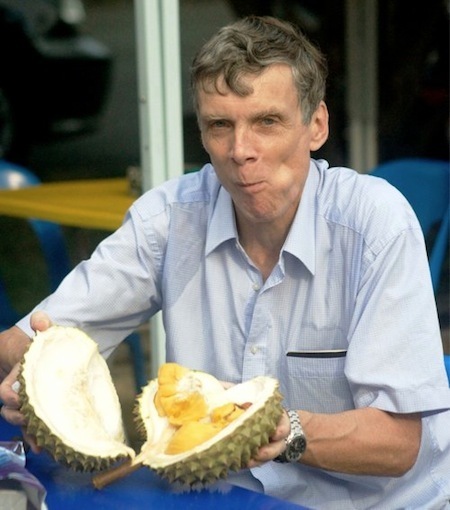Marc Abrahams's Blog, page 453
October 29, 2013
What Eats What Where Near Singapore
Appetite is just part of this investigation of food and feeding:
“Scavenging of dead invertebrates along an urbanization gradient in Singapore,” C.K.W. Tan [pictured here, right] and R.T. Corlett [pictured here, below], Insect Conservation and Diversity, vol. 5, no 2, 2011, pp. 138-145. the authors, then at National University of Singapore but now respectively at Oxford University, UK and Xishuangbanna Tropical Botanical Garden, Chinese Academy of Sciences, report:
“Little is known about the animals that scavenge invertebrates in the tropics and the impact of human activities on such organisms. We studied the scavenging process using baits representing five dead invertebrate types in six habitats along an urbanisation gradient in equatorial Singapore… The bait was observed every 40 min for 200 min after placement and then after 1 day. The bait was considered as successfully scavenged when it was moved >10 cm from its initial location or >80% of it was consumed (determined by visual observations by the same observer)…. A species was considered a scavenger if it attempted tomove the bait,moved the bait and⁄or fed on or fragmented the bait….
Detail from the study:

October 28, 2013
“Intellectual Sewing”: Keeping Proust in Stitches
A new academic sub-discipline is born:
 “Sewing Proust: Patchwork as Critical Practice,” Rhiannon Williams [pictured here], Textile: The Journal of Cloth and Culture, Volume 1, Number 1, November 2013 , pp. 43-56. (Thanks to investigator Neil Martin for bringing this to our attention.) The author, at the University of Derby, explains:
“Sewing Proust: Patchwork as Critical Practice,” Rhiannon Williams [pictured here], Textile: The Journal of Cloth and Culture, Volume 1, Number 1, November 2013 , pp. 43-56. (Thanks to investigator Neil Martin for bringing this to our attention.) The author, at the University of Derby, explains:
“I describe my own work, somewhat provocatively, as ‘intellectual sewing’ conducted in the manner of a critique. My methodology supports the agenda for integration of theory into practice, arriving at an interdisciplinary approach that promotes mutuality of theory with practice as a working model. In 2008 I began to cut up all seven volumes of Marcel Proust’s novel A la recherche du temps perdu and to hand stitch 3,000 pages of print into patchwork…. cogitates through practice, exploring the nature and experience of time at the beginning of the twenty-first century. That is to say, what might it mean to take apart then stitch together Proust’s Modernist text 100 years after its production?”
An alternate version of part of the Williams text is online.
BONUS: Monty Python’s All-England Summarize Proust Competition:

300,000 to 450,000 Cows Per Zeppelin, approximately
Some say that the German Army General (retired), Ferdinand Adolf Heinrich August Graf von Zeppelin, was a man “who made the improbable probable.” For an example of this viewpoint, see the website of Zeppelin University (based on the shores of Lake Constance, Germany)
“
Graf Zeppelin was a manager at the end of the 19th century the likes of whom cannot be described in textbooks and who, for exactly this reason, can function as a role model for a university: committed to innovation, operated internationally and rooted in the Lake Constance area, visionary and strong-minded. In short: Someone who made the improbable probable because that is what he wanted. The worldwide fascination with airships is ultimately a fascination with willpower.“ [our emphasis]
One of the improbable developments that the role-model achieved was to oversee the design and implementation giant airships based around huge gasbags made from cows’ intestines (a.k.a. Goldbeater’s skins), which were filled with über-flammable hydrogen. The production of these ships became so important to the German government of the day (which used them to shower London with inextinguishable thermite-based incendiary bombs) that the manufacture of sausages (also made from intestines) was temporarily banned.
The subject has recently received attention due to the UK-based Channel 4 TV production ‘Attack of the Zeppelins’
“This new kind of terror campaign rewrote the rules of war. For the first time in history, innocent civilians were bombed in their homes in a ruthless attempt to break a nation’s morale.”
Although the TV programme generated intense media activity (often focusing on the salami ban) [example], very few of the news-stories linked to the original document from which sausage data came. But Improbable has tracked down a copy – a translated version of the journal L’Aéronautique, (1922) chapter : ‘Balloon Fabrics made from Goldbeater’s Skins’ by Capt. L Chollet, of the S.T.Ae.
“Goldbeater’s skin from oxen and cows did not enter alone into the composition of the fabrics made by the Germans during the war. One animal furnishes only one such skin and 15 of them were required to prepare one square meter of the fabric. Twenty four Zeppelins, each with a ballonet surface of 20,000 to 30,000 sq. m., were put into service in 1917.”
Note: That’s somewhere around about 300,000 – 450,000 Cows Per Zeppelin (c.p.z.), considerably more than was suggested by many of the media articles. The journal chapter can be downloaded and read in full.
BONUS UPDATE: “New Hampshire could only build 1/6th of a WWI Zeppelin – we don’t have enough cows”

October 27, 2013
Vampires, and multiple Dr. Frankensteins, and Cadaver-cutting
Information of possible use as Halloween approaches:
 Vampires: The study “Co-Existence of Vampires and Humans Is Possible: Proofs Based on Models Derived from Fiction Literature, Comic Books and Films,” by Wadim Strielkowski [pictured here], Evgeny Lisin, Emily Welkins [author of the book
Till the Last Drop
]. [NOTE: the paper, which appeared in the Annals of Improbable Research, has since reappeared, vampirishly, in Modern Economy, Vol. 3 (7): 826-831, and in Applied Mathematical Sciences, vol. 7, no. 9-12: 453-470.]
Vampires: The study “Co-Existence of Vampires and Humans Is Possible: Proofs Based on Models Derived from Fiction Literature, Comic Books and Films,” by Wadim Strielkowski [pictured here], Evgeny Lisin, Emily Welkins [author of the book
Till the Last Drop
]. [NOTE: the paper, which appeared in the Annals of Improbable Research, has since reappeared, vampirishly, in Modern Economy, Vol. 3 (7): 826-831, and in Applied Mathematical Sciences, vol. 7, no. 9-12: 453-470.]Frankenstein: Here a Dr. Frankenstein, there a Dr. Frankenstein…
Pumpkins and cadavers: Testing pumpkin-carving knives on cadaver arms
BONUS: Download the poster “Vampires Exist” by Strielkowski, Lisin, and Welkins:

They collect laughs
Laughter aggregated:
“ILHAIRE Laughter Database,” Gary McKeown [pictured here], Roddy Cowie, Will Curran, Willibald Ruch, Ellen Douglas-Cowie, Eighth international conference on Language Resources and Evaluation (LREC) Istanbul, Turkey, 2012. The authors, at Queen’s University, Belfast, UK and the University of Zürich, Switzerland, explain:
“The ILHAIRE project seeks to scientifically analyse laughter in sufficient detail to allow the modelling of human laughter and subsequent generation and synthesis of laughter in avatars suitable for human machine interaction. As part of the process an incremental database is required providing different types of data to aid in modelling and synthesis. Here we present an initial part of that database in which laughs were extracted from a number of pre-existing databases. Emphasis has been placed on extraction of laughs that are social and conversational in style as there are already existing databases that include instances of hilarious laughter.”
The ILHAIRE database is accessible to those who agree to certain conditions.
The encompassing ILHAIR Project web site includes a list of public deliverables, some demos (including the Body Laughter Index), and more.
BONUS, by the lead author: ”The Analogical Peacock Hypothesis: The sexual selection of mind-reading and relational cognition in human communication,” Gary J. McKeown, Review of General Psychology, Vol 17(3), Sep 2013, 267-287.

October 26, 2013
mini-AIR October issue: Fessler on Feet
 The October issue of mini-AIR (our monthly newsletter — it’s a wee little supplement to the magazine) just went out. You can read it online, too. Topics include:
The October issue of mini-AIR (our monthly newsletter — it’s a wee little supplement to the magazine) just went out. You can read it online, too. Topics include:
Fessler on Feet
Fessler on Feet Limerick Competition
Fessler on Foot andMouth Disease
and more
It also has info about upcoming events.
Mel [pictured here] says, “It’s swell.”
mini-AIR is the simplest way to keep informed about Improbable and Ig Nobel news and events. Just add yourself to the mini-AIR list, and mini-AIR will be emailed to you every month.
 BONUS: Fessler (pictured here)
BONUS: Fessler (pictured here)

The power of narrative non-journalism with added Attenborough
These videos demonstrate the power of narrative. The voice is that of David Attenborough. The videos were constructed by the people at Wreck & Salvage (specifically: Erik Nelson, Adam Quirk, and Aaron Valdez):
Photosynthesis and the origin of life:
Mating ritual of two twits:
(HT Ed Yong and Jennifer Ouellette)

October 25, 2013
The math controversy that, they say, led to a mental breakdown
 In an essay called “The Root of Infinity: It’s Surreal!“, the ThatsMath blog writes about a dark side to the power of numbers. The Cantor mentioned here is George Cantor [pictured here], who pretty much created the branch of mathematics now called number theory:
In an essay called “The Root of Infinity: It’s Surreal!“, the ThatsMath blog writes about a dark side to the power of numbers. The Cantor mentioned here is George Cantor [pictured here], who pretty much created the branch of mathematics now called number theory:
… But the extended system was hugely controversial, and for good reasons. For example, Cantor found that
. His system was not commutative under addition. In fact,
. We might be tempted to subtract
from each side, but this would yield the nonsensical result
. The controversy was a factor in Cantor’s mental breakdown and ultimate suicide.

New brand of underwear: The newness smells suspicious
News reports in Britain and elsewhere tout a new British brand of underwear, named “Shreddies“, that uses a carbon filter to trap bad-smelling gasses. The manufacturer says the underwear is “award-winning“. This video compilation shows several recent TV accounts of it:
But the basic product is not new, nor is it British.
The original such product is Under-Ease, invented by Buck Weimer of Colorado. For inventing Under-Ease, Mr Weimer was awarded the 2001 Ig Nobel Prize for biology. Here’s a TV interview with the inventor:
Under-Ease has a removable charcoal filter. The new British product reportedly has a filter that irremovable. Such is progress.

“Willy-Nilly” (the evolution of)
 The Proceedings of the Twenty-Second Annual Meeting of the Berkeley Linguistics Society: General Session and Parasession on The Role of Learnability in Grammatical Theory (1996) featured one of the very few scholarly investigations into the origin(s) of the expression “Willy-Nilly”
The Proceedings of the Twenty-Second Annual Meeting of the Berkeley Linguistics Society: General Session and Parasession on The Role of Learnability in Grammatical Theory (1996) featured one of the very few scholarly investigations into the origin(s) of the expression “Willy-Nilly”
Author Paula Kadose Radetzky (University of California, Berkeley) notes that although “Willy-Nilly” originally meant ‘unwillingly’, it has now evolved into meaning (almost) the reverse, viz. ‘howsoever one pleases’.
Raising the question:
“How does an expression go from meaning one thing to meaning another – even its opposite?” To find out, read : To Will or Not to Will: The Evolution of willy-nilly. The paper also hints at opportunities for future research, noting the author’s intent to investigate : Hodge-Podge, Dilly-Dally and Zig-Zag.
also see: Much ado ablaut flim flam

Marc Abrahams's Blog
- Marc Abrahams's profile
- 14 followers







